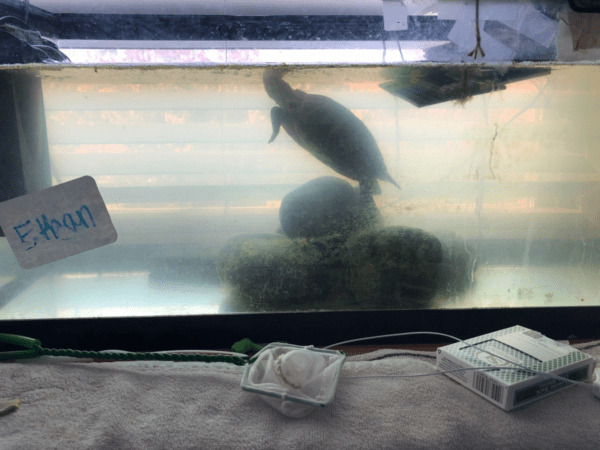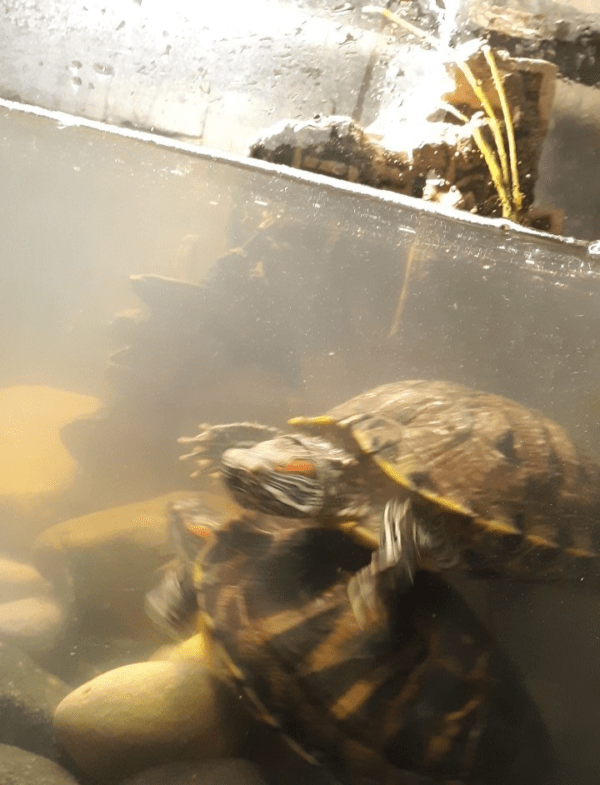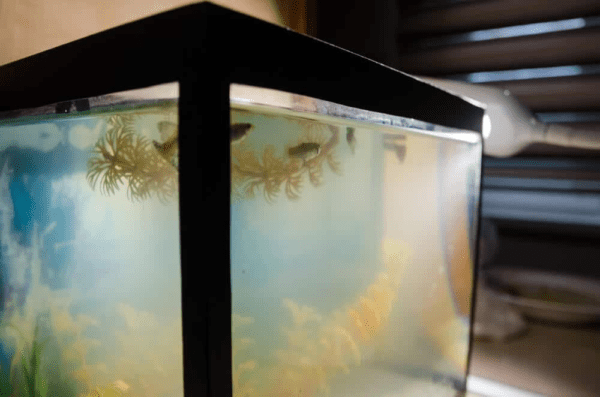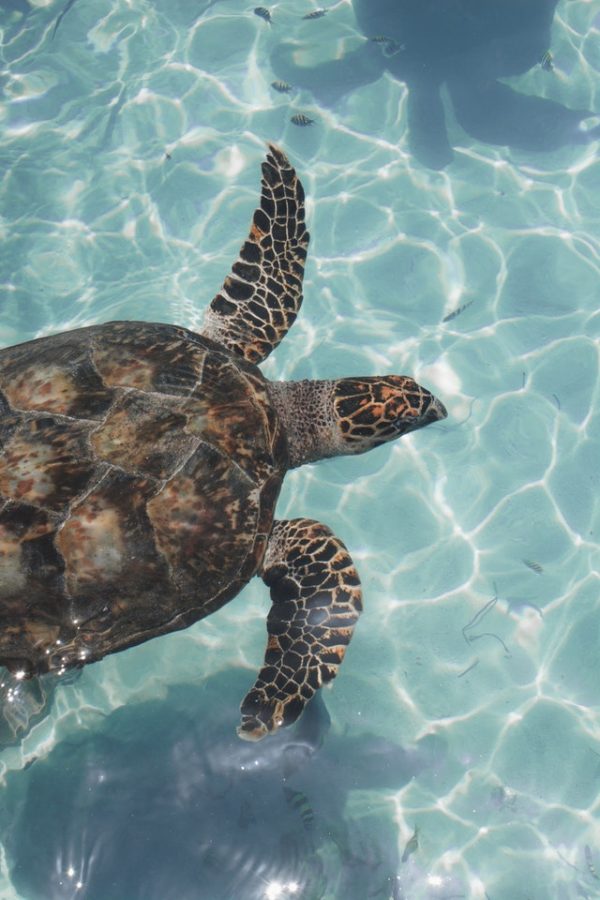If you have a turtle as a pet, you need a tank to provide it with its own space of freedom. It will be its home and a small paradise within your family. So, how to make sure that the tank isn’t getting cloudy over time.
Even though you keep adding new filters to your tank, you are losing it all if you cannot clean it periodically. Also, you need to keep in mind that turtle waste causes a lot of cloudiness around the water. As a result, you end up with a dirty tank!
Not anymore! Turtle tanks are cleanable and easy to maintain. The only thing it needs from you is time & patience.
This article will give you clarity on how you can keep the turtle tank water clean. Moreover, it also explains to you the causes behind the cloudiness of the water.
Table of Contents
What Causes Cloudy Tank Water In A New Aquarium?

The reason behind a cloudy tank is mostly the unbalanced chemistry of water. In fact, the main root cause of cloudy water is the excessive amount of bad bacteria in the tank. If you haven’t made a mistake by adding any chemical to the tank, then the cloudiness will settle itself.
But you need to understand the science and process behind it. When the water in your tank starts to look cloudy, it means the tank water is unbalanced. There are possibly two scenarios that you will face, that includes:
- Your new & fresh tank water is turning cloudy.
- Your existing old water keeps turning cloudy frequently over time.
These are the scenarios that you will mostly encounter if you have an aquarium or tank in your house.
Cloudiness Due To Addition Of Substrate To New Turtle Tank/Aquarium

Setting up a new aquarium or a turtle tank and observing cloudiness in tank water is mostly due to the substrate. All of the substrates you use in the turtle tank water should be rinsed to remove the epoxy coating.
If you don’t rinse it, then they can be really dusty for the fresh turtle tank water. You can get it done by rinsing it in small quantities. As a result, you can rinse it thoroughly! It is one of the probable reasons for aquariums to get the dust coating.
Cloudiness Due To Use Of Tap Water
If you use tap water to fill your turtle tank, you are probably making the biggest mistake. There is a chance that tap water might consist of nitrates, silicates, phosphates, and metals. As a result, it contaminates the water and makes it look dirty.
If you want to use tap water, then you should use a water conditioner for the same. A water conditioner has the potential to neutralize chlorine, ammonia levels, nitrite levels, metals, and other impurities from the turtle tank water.
Cloudiness Due To Nitrogen Converting Bacteria
It is yet another potential reason for you to experience a cloudy turtle tank. When you get a new turtle tank and fill it with fresh water, nitrogen converting bacteria colonize for oxidizing the nitrites and ammonia.
This bacteria bloom can occur in turtle’s water right after you make water changes. It is not that the bacteria is degrading, but the sudden peak of nutrients in water gives rise to such heterophobic bacteria.
This bacteria aims to break down the fish waste, decay the debris of plants, and turn the unconsumed turtle food into ammonia.
As a result, a bio-film forms over the decorations and walls of the turtle tank. And as this bacteria multiplies exponentially fast, you will soon observe a cloudy turtle tank.
If you are bringing in a new aquarium or turtle tank without any turtle or fish, you just need to naturally let it go through this nitrogen cycle. Then, add your turtle or aquatic beings only after the tank has matured.
You can also prefer reducing the excess food amount, frequent water change, cleaning substrate, and lowering nutrients to avoid getting a cloudy tank so frequently. For better help, you can add live plants to lower the nutrient levels in turtle tank water.
Cloudiness Due To Algae Blooms
It is one of the most crucial causes of green & cloudy turtle tank water. Out of all the types of cloudy tank syndrome, the green water is pretty much tough to rectify. Green water is considered to be the cause of all the algae cells. It is termed Euglena!
This condition originates because of overstocking the tank or over-feeding the turtles & other aquatic beings. Algae will not just contribute to turning freshwater into cloudy turtle tank water but also deplete the oxygen from water during the night.
Therefore, you need to get rid of it by not just cleaning or changing water. But, you also need to make use of UV light filtration to kill such cells. Hence, their population will reduce, and there will be no cloudiness or discoloration.
Cloudiness Due To Aquatic Decor Items

There is a potential outcome of cloudy brown water, using a popular driftwood decor item for aquariums & turtle tanks. But it only results in cloudiness if it isn’t soaked before adding it into the tank.
As a result, this decor item discharges brown coloration to the tank. This color is discharged due to the release of tannic acid. It can be taken off with regular clean-up and water changes. Make use of chemical filtration with carbon that will clean the water thoroughly.
If there is cloudy brown water due to driftwood, you must keep in mind to check the pH levels of water. It is because the tannic acids have properties to lower the pH level of water.
Cloudiness Due To Too Much Light
One of the other evident reasons for witnessing cloudy turtle tank water is too much light. Most people set their turtle aquarium in direct sunlight or add up a lot of lights to it. As a result, they contribute to the growth of algae in the tank.
With algae growth, you can expect a layer of cloudy film accumulating over decor items and walls of the tank. Hence, you will experience a dirty turtle tank with cloudy water.
You have to lower the time for keeping your lights on. You can then move the aquarium to a different location, where there is no direct sunlight. In this way, you can make sure to prevent the cloudy turtle tank water situation.
These are the probable reasons or causes of cloudy water tanks. Of course, all of these causes can be avoided with rightful measures. But most of the owners are unaware of how the cloudy tank can be attended to. Even before that, the owners are unaware of keeping the turtle tank clean without letting the cloudy water intervene with its appeal.
Turtle tanks are just like fish tanks and demand the same purpose of cleaning. So, the next few sections are provided to help you come up with solutions to overcome these causes of cloudiness.
How Long Does Cloudy Water Last In A New Aquarium?
There is a term said, New Tank Syndrome or NTS! It occurs if you have recently changed your tank or installed any new tank at your residence. With this new tank syndrome, there will be some form of cloudiness for sure, irrespective of whether you use tap water, purified water, or distilled water.
Turtles are quite messy creatures, and they poop a lot in water. Hence, they have the potential to ruin the fresh water in minutes. If your tank is already going through the new tank syndrome, you should know that everything begins when the turtle produces waste in clean water.
The Beneficial Bacteria
The beneficial bacteria within the filter will consume these wastes! But as you know, turtles generate a lot of waste in their initial days in the new turtle or fish tank; there are not enough beneficial bacteria within the filter to consume the turtle waste efficiently.
Hence, you can conclude that the production of turtle’s waste exceeded the count of beneficial bacteria.
So, the ammonia and nitrite levels go up the mark, and you get a tank with cloudy water. You need to add up a filtration system to keep the water clean within the tank or wait until the water can attain a proper cycle naturally.
The Wait For Proper Cycling Of Water
It might take some time for the cycle process to restore its balance. This might take a few days or up to a few weeks, depending upon the size of the tank and the amount of water.
The power of your filter media to remove waste and its size is also a matter of concern for the longevity of the cloudiness.
If you have all things in working condition and set to optimal levels, the beneficial bacterial colonization will rise to normal levels. As a result, all the waste will be absorbed by it seamlessly.
How To Deal With NTS?
New Tank Syndrome (NTS) lasts for a few days if you are not treating it with ideal measures. If you intend to get rid of it before it naturally does, then you need to try out the below methods:
1. Do Not Use Chlorine-Treated Water
Chlorine is proficient in killing bacteria. Therefore, it is used in swimming pools for water treatment. But it isn’t good for tanks with aquatic turtles.
Chlorine will kill the good bacteria, along with the bad ones. As a result, it will slow down the NTS cycle, and the cloudiness will last for longer.
2. Aerating Your Water
If the water flow in your tank has a low oxygen level due to the build-up of ammonia and nitrite levels, then it might just inhibit the good bacteria growth.
Therefore, you need to keep in mind to aerate the water to speed up the process of good bacteria growth and improve oxygen levels in the water.
So, the easiest way of aerating the tank water is by introducing an air pump to the tank. An air pump will work on aerating and improving the water quality for eradicating cloudiness. It will suppress the ammonia and nitrate build-up, and the cycle will process faster.
3. Clean The Tank Filter
The next step to ensure that you speed up the cycle process of NTS is cleaning the canister filters and other water filters.
You need to follow the instructions of your water filter solutions to make sure it works. For larger tanks, you will probably consider cleaning them under a running faucet.
But, in the process, you are wiping out all of the beneficial bacteria from the tank. So, it is better you follow other cleaning processes rather than doing it underneath a faucet.
There are water filtration systems that will help you clean out the tanks without killing the good bacteria. So, consider following them.
Now, you know that it lasts for around a few weeks or days until the NTS cycle completes. And this is the natural way of settling down the cloudiness of your turtle tank.
It is now time for you to get an insight into how you can prevent your aquarium water from getting dirty.
Ways To Prevent Cloudy Aquarium Water

The best thing you can do to prevent turtle tank water, the cloudy appeal is by following these below ways or measures:
1. No Overfeeding
As you overfeed the turtles in your tank, they produce waste in the heavy count. Therefore, the turtle’s aquarium starts to look hazy, as the good bacteria production needs time to absorb all those wastes.
You should feed your turtle only that much food that they can finish within 2 minutes. Start this habit right from the moment you get your first turtle. It will help you maintain the cleanliness of the water, and you will need fewer water changes.
2. No Overcrowding- Less Turtle Waste
If you are buying a tank for turtles, then you prefer to keep turtles in it only. Most people have an intention to get a working fish to obtain a clean tank over time. Unfortunately, the working fish often eats up the waste in water to keep it clean.
Ghost shrimp is such a working fish that keeps the water clean. But if you are adding up such fishes to your tank for turtles, then make sure you are not overcrowding it. Overcrowding the tank will suppress the potential of the filter to produce a good bacteria colony.
Moreover, it will also hamper the proper flow of oxygen, making it difficult for aquatic animals to survive. If you intend to have various fishes alongside turtles, then consider having a separate container or tank for the same.
Also Read: Why do Turtle Stack
3. Adding Activated Carbon To Tank Filter
Water change is essential over time, but you need to try and delay the periodic interval as much as possible. And for the sake of reducing your annual water changes, you must add activated carbon to the filter media.
Along with mechanical filtration of turtle food, waste, and other such things, and biological filtration with beneficial bacteria, there is an urge for activated carbon filtering as well. By adding carbon, you can remove the tannins that usually stain the water to make it cloudy.
This will probably delay your water change needs over time. As a result, you can take some breaks from frequent monitoring and observation of your tank water.
4. Seed The Aquarium
If you are putting up a new tank or aquarium setup, you can consider preventing bacterial bloom and cloudy water conditions. And for that, you can implement seeding in your aquarium!
Under this process, you should transfer the plants, substrate, and decorations from any older tank to a new one.
As those items have beneficial bacteria in them, the new tank cycle will kick start eventually. Hence, it will reduce the possibility of an increase in nitrate levels and ammonia levels.
It will also reduce the cycling time by 50%. With it, there is a very low chance that your turtle’s tank will turn cloudy.
5. Additional Prevention Measures
Here are some of the additional things that you must carry out to prevent cloudiness:
- You must get a water testing kit to check the pH levels and oxygen levels. Therefore, before utilizing any neutralizing chemical, using the water test kit is important.
- Use a gravel vacuum to remove the gravel residues from the tank, as it causes white cloudiness in the water.
- You can use bacteria supplements to speed up the growth of beneficial bacteria. These bacteria supplements are easily available at any regular aquarium business store.
- Add one or two ghost shrimps to your tank as they eat algae. The fish will be eating algae and will be helping you delay the water changes.
- Use a general aquarium vacuum to clean all of the stuck residues from it.
- Use a UV sterilizer to suppress the growth of algae in your tank. UV Sterilizer is available at different pricing at online & offline stores.
- Regulate the water temperature as well to keep the good bacteria alive. They cannot survive in hot waters.
- You must have a general aquarium filter in your tank to ensure that it absorbs the wastes and unconsumed food efficiently.
- Avoid using tap water that has signs of too much ammonia in it. Instead, you can use the water testing kit to check it. If you find ammonia in it, then perform water changes.
- Do not use saltwater.
Summary
As of now, you are aware of how ammonia and nitrite, water quality, gravel residue, bad bacteria, and other such reasons can make the water cloudy. Therefore, it is now time for you to carry out the remedies mentioned above to overcome them.
Also, mechanical and biological media for filtration are not sufficient because you need to implement artificial measures.
